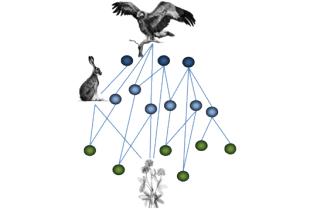Aims

This study aimed to capture the complexity of species interactions - within and between trophic levels - and ecological and evolutionary processes in the context of climate change. This was done through the development of a theoretical framework, investigating how
(I) the response of plants to climate change is affected by the presence of herbivores, under
(II) the influence of different scenarios of dispersal and evolvability
Two different type of networks were created; bipartite networks, consisting of two trophic levels (herbivores and plants), and competition networks, consisting of the basal trophic level (plants).
The effects of temperature on the intrinsic growth rate of species was used to evaluate the response of species to climate change. The close relation between temperature and intrinsic growth rate (fitness) was expressed using tolerance curves. These tolerance curves described species different tolerances to non-optimal temperatures, and evolution was allowed to operate on temperature optima.
Responsible for this page:
Director of undergraduate studies Biology
Last updated:
06/01/14
